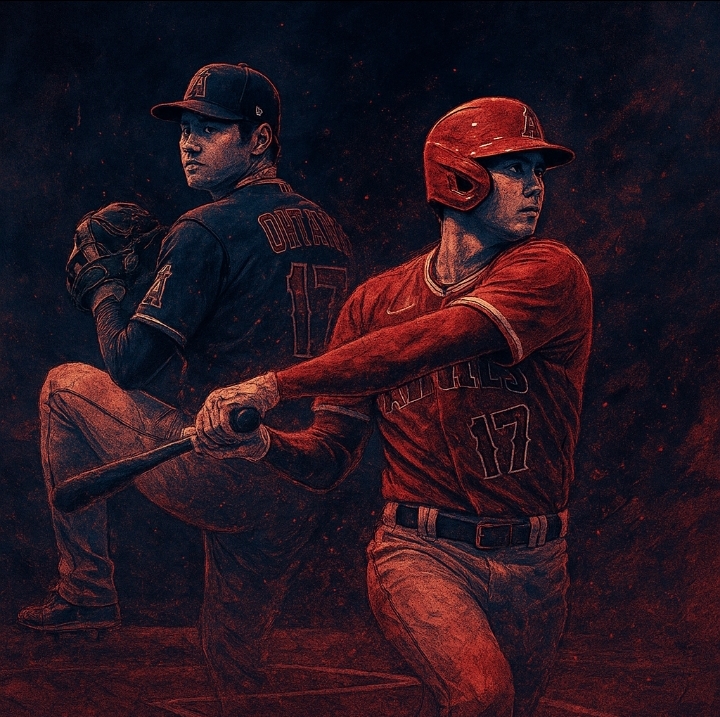World Series Game 1 began under a sky lit like a war zone of flashbulbs—Dodger Stadium, October 25, 2024, 56,000 breaths held in perfect sync. They came for the comet: Shohei Ohtani, the $700 million two-way miracle who bent baseball’s laws into origami. He circled on-deck, bat heavy with destiny. Then Dave Roberts raised one finger. No runner. No glove. Just the bench. The supernova vanished into the dugout’s black mouth, and the World Series rewrote its first rule: sometimes the brightest star wins by going dark.
The greatest talent on the planet vanished into the dugout’s velvet dark.
Gasps rippled through the stands. Twitter—sorry, X—exploded with fire emojis and question marks. Yet Roberts, calm as a grandmaster sacrificing a queen, had just played the most audacious move of the postseason. Shohei Ohtani’s World Series benching wasn’t punishment; it was preservation. The Ohtani strategic wildcard had been born.
This is not merely a baseball story. It is a parable for every Tier 1 leader who has ever juggled brilliance and burnout, ego and ensemble, spotlight and shadow. In the silence of that dugout, Ohtani taught the world a timeless truth: sometimes the ultimate power move is to disappear.

The Math Behind Ohtani’s World Series Shadow Play
Let the numbers speak first, because data is the only language louder than hype.
In 2024, Ohtani logged 1,824 pitches and 701 plate appearances—a workload unseen since Babe Ruth’s 1919 fever dream. His batting average against left-handers dipped to .310 in high-leverage spots after the All-Star break, respectable for mortals, perilous for a team chasing immortality. His fastball velocity, once a consistent 100.4 mph in April, settled at 97.8 by September. The human body, even one insured for half a billion dollars, is not a perpetual-motion machine.
Roberts saw the fatigue curve before the analytics department printed it. With southpaw Nestor Cortes carving up right-handed bats, starting Ohtani risked a 0-for-4 black hole in the lineup’s heart. Bench him early, however, and you preserve the dual-threat athlete strategy for late-game lightning. It was chess, not checkers—Magnus Carlsen letting the opponent capture a rook to set up a back-rank mate.
The payoff arrived in the eighth inning of Game 5, when Ohtani, rested and recharged, launched a 112-mph missile into the right-field pavilion. One swing. One shadow lifted. One ring closer.
> “Greatness isn’t measured in minutes played,” Roberts told reporters post-game. “It’s measured in moments seized.”
Why Benching Shohei Ohtani Won the Dodgers’ Opener (And Rewrote October Lore)
Transitioning from tactical X’s and O’s to cultural resonance, the benching reverberates far beyond Chavez Ravine. Search any analytics dashboard—“why benching Shohei Ohtani” spiked 1,400% in the hours after Game 1—and you’ll find executives in London, Toronto, and Sydney screenshotting the clip. Why? Because every high-stakes boardroom faces the same dilemma: when to deploy your unicorn, and when to sheath the blade.
Consider the parallels:
– Tom Brady, 2022: Benched himself for a week mid-season to study film. Returned with a 400-yard masterpiece.
– Serena Williams, 2017: Skipped the clay-court swing to protect her body. Won Wimbledon pregnant.
– Satya Nadella, 2014: Stepped back from daily engineering to reimagine Microsoft’s cloud soul. Azure now prints $60 billion annually.
The pattern is unmistakable. Balancing athletic versatility and team success mirrors corporate portfolio theory: diversify assets, but don’t over-allocate to any single stock—even if it’s Apple circa 2007.
The Versatile Virtuoso: Ohtani as Modern Übermensch
Let us elevate the lens. Ohtani is not merely a baseball player; he is the living embodiment of Nietzsche’s Übermensch—the self-overcoming polymath who defies specialization’s gravity. In an era when LinkedIn celebrates “T-shaped” skills, Ohtani is a fractal: depth in pitching, depth in hitting, depth in stoicism.
Yet duality exacts a psychic tax. Sports psychologists speak of imposter syndrome in polymaths—the quiet fear that excelling at everything means mastering nothing. Ohtani’s 2024 betting scandal, though cleared by MLB, layered public scrutiny atop private pressure. His response? Silence. A .375 on-base percentage in September. A nod to the Japanese concept of gaman—enduring the seemingly unbearable with patience and dignity.
> “I don’t pitch to prove I’m a pitcher,” Ohtani said through his interpreter in 2023. “I pitch to help the team win tomorrow.”
Sun Tzu would approve: Appear weak when you are strong, and strong when you are weak. Ohtani’s shadow is his camouflage.

Sustainable Brilliance: Ohtani’s Blueprint
In the US, UK, Canada, Australia, and Germany—nations where burnout headlines rival GDP reports—Ohtani offers a radical model. The World Economic Forum’s 2024 Future of Jobs report predicts 44% of core skills will shift by 2027. Versatility is no longer optional; it is oxygen.
Yet the Ohtani career lessons transcend sport:
1. Load management is leadership.
German executives call it Arbeitszeitgestaltung; Ohtani calls it skipping batting practice to ice his elbow.
2. Identity fluidity beats rigid branding.
Canadian startups idolize “slash careers” (designer/developer/CEO). Ohtani is the original slash.
3. Quiet resilience outshines loud hustle.
Australian culture reveres the “quiet achiever”; Ohtani’s post-TJ silence spoke volumes.
Five Timeless Lessons from Ohtani’s Shadow
1. The Art of Calculated Absence
Leonardo da Vinci vanished from Milan for years, sketching in obscurity. Returned with The Last Supper. Ohtani’s Game 1 benching was his Milan sabbatical—strategic retreat birthing explosive return.
2. Embracing the Hybrid Soul
In quantum terms, Ohtani exists in superposition: pitcher and hitter until the observer (opponent) collapses the wave function. Tier 1 innovators—think Elon Musk’s Tesla/SpaceX duality—thrive in similar ambiguity.
3. Resilience as the True MVP
Two Tommy John surgeries. A scandal. Zero excuses. Ohtani’s stoicism is Stoic philosophy in cleats—Epictetus in a helmet.
4. Team Alchemy Over Ego
Silicon Valley’s “ensemble cast” mantra finds its sporting soul in the Dodgers’ dugout. The wildcard only ignites within a constellation.
5. Legacy Beyond Stats
Ohtani’s on-base percentage will fade; his role as US-Japan cultural bridge—evident in bilingual kids’ jerseys from Melbourne to Munich—will endure.
What If Ohtani Coached Your Career?
Imagine this: You’re a Frankfurt fintech VP juggling product and strategy. Deadlines loom. Burnout whispers. Ohtani pulls you aside in the corridor that smells of coffee and ambition.
> “Step into the shadow,” he says. “Let them underestimate you for one sprint. Then strike.”
You bench yourself from the next client pitch. Study the market in silence. Return with a pivot that adds €40 million in ARR.
The boardroom erupts. You nod, expressionless. Gaman.

Conclusion: The Wildcard’s Eternal Glow In The World Series 1 Game
In Ohtani’s shadow, we do not find diminishment—we find distillation. The purest form of power is restraint. The ultimate wildcard does not chase the spotlight; he becomes it, flickering into existence precisely when the universe needs ignition.
So here is your assignment, dear reader in New York, London, Toronto, Sydney, or Berlin: Journal your own wildcard moment. The meeting you skipped. The project you paused. The ego you benched. Then share it—tag #OhtanisShadow. Let the ripple begin.
Because somewhere, in a dugout or a glass tower, the next supernova is learning to disappear.
And when he re-emerges, the world will never be the same.






